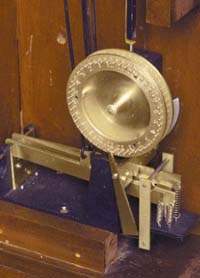|
This clock represents an enhancement in pull cord design over the Davis, Polsey & Co. clock (I.D. 495), and is undoubtedly the last of the kind. It had come into existence in the early 1860s, probably soon after Howard left his partnership with David Davis and started his watch
ventures. The company's 1874 Catalogue lists this pull-cord watch clock (No. 26) along with an improved model. It also introduces an early version of the new Electric Watch Clock (I.D. 496)
, which soon supplanted all the pull cord types. In this final embodiment of the pull cord concept, as in the Davis, Polsey design (and undoubtedly in the earlier Howard & Davis design), iron wires are used to transmit
mechanical motion when the watchman "pulls" each remote station. In this new design, Howard continued use of levers to move a transverse bar to push the
registration pin. By a "pull" from the remote station, the end of the lever is forced against an inclined plane cut it the bar (see I.D. 495)
. One of the levers must be the first one actuated. It moves the bar enough to allow the second to be pulled, and then in sequence a third and (in this unit) a fourth can be pulled. The essential difference in
this design, however, is that the first two levers move the bar in the direction to push the record pin into the pin dial, but then the second two levers, by an inclined plane of opposite orientation, move the transverse bar back
to the starting position. Just two pulls actually move the recording pin, but the additional pulls are compulsory and hence just as much a part of the tour record. In this design the intricate cutting of the ratchet
teeth in the bar, the ratchet arrangement itself, and the return spring, are eliminated.A greater innovation, however, lies in separating the recording system from the clock movement. This lifted all the restraints of the
earlier design related to having to fit the recording mechanism between the movement plates. In this design, the entire recording mechanism is mounted on an iron frame fastened to the bottom of the clock case and covered with a
dust box. The pin dial shows in a circular window at the bottom of the door. While this unit was fabricated for four stations, the spacing within the frame appears to be ample for at least four more levers, i.e. four more stations.
Thireedom to assemble easily for different station capacities is obviously the principal improvement in this design. Though it is obvious that additional levers can be added readily, there's not a hint how the bar would be cut to
accommodate 5, 6, 7 or 8 stations. |
|
|

